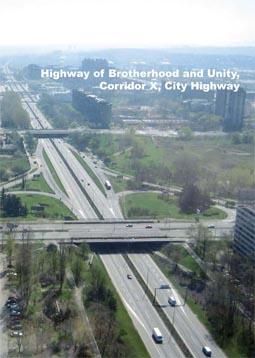Highway of Brotherhood and Unity, Corridor X, City Highway

Students: Kaj Plattner, Patrick Rinderknecht
Location: Group work in Belgrade
Date: July, 2006
Type: Research project, student work
One of Europe’s major highways – Corridor X – will run through Belgrade on its way from Vienna to Istanbul. It largely follows the Highway of Brotherhood and Unity that linked the major Yugoslav cities. This is an important spatial artifact: it is realized on the scale of old Yugoslavia as an expression of the ideology of Brotherhood and Unity that integrated its different peoples. It is more than just an infrastructural element; it has monumental aesthetical qualities. The Highway of Brotherhood and Unity approaches old Belgrade over a beautifully scenic axis that organizes New Belgrade. A similar approach we can find in Zagreb. From the airport, the highway approaches the old city centre over an axis organizing New Zagreb. Over this axis, one constantly sees the roofscape of the old city with the mountains behind it.
‘When designing the city highway in Beograd, the idea was that it is, in the first place, a busy town traffic road and all its elements had to meet town planning and public services standards. Special attention had to be paid to the mentioned problems in connection with the section passing through the urban part of Novi Beograd which is situated on flat ground. Due to that the roadway was lowered 3 to 4 m and 2.8 m below the flood flow of the river Sava. The basic highway route was designed for the speed of V=100 km/h. The highway has two one-way carriageways with three traffic lanes (2x11.5 m), medians of 2 m in the old part of the town and 3.5 m in Novi Beograd. The carriageways are bordered with concrete prefabricated elements and are provided with town-type sewage system. In the average 47,000 vehicles per day drive along this road as well as the rapid public town transport with more than 100,000 passengers daily. To prepare the route for the highway in the old part of the town, about 1,000 residential units and 136 industrial buildings had to be pulled down. To build the road bed and remodel the terrain over 2,000,000 m3 of soil material was used.’
Today, this highway still cuts through the very center of the city. According to European standards, a detour route has been planned for heavy traffic. With its new function as European Corridor X, it still connects the important cities in the countries that used to form Yugoslavia but above all it gives Belgrade a position in Europe. This position in the EU does not represent so much the cultural ideals from the Tito's period. Rather, it triggers new developments such as business, commercial parks, and new housing estates docking onto it.
Much like ‘Learning form Las Vegas’, this case study can be seen as a ‘strip’ project on the scale of a highway cutting through the city in a length of about 20 kilometers.
Download the Book PDF

